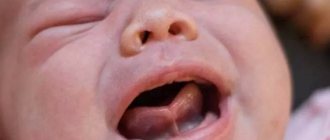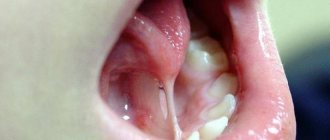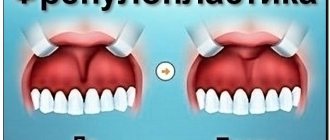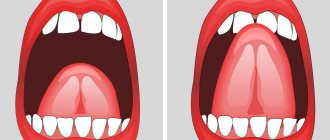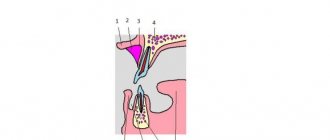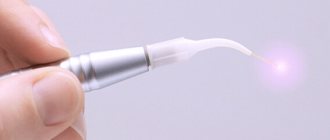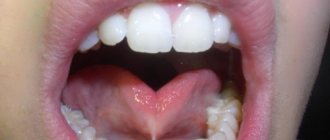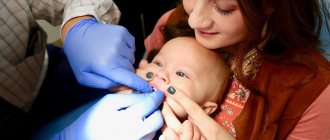Why perform a frenulum trim?
Some violations in the structure of the frenulum lead to quite serious consequences. If there is a short mucous membrane under the tongue, its movement is difficult, which means the patient cannot eat properly, and speech therapy problems appear. In infancy, the baby will not be able to fully suck mother's milk, and therefore the frenulum is cut in the first weeks or months of life.
If trimming the frenulum of the tongue is most often carried out in infancy, then the problems of the short mucous membrane of the lips (usually the upper) may not be so obvious. Shortened and non-elastic films can lead to tension in the gums, a reduction in its volume and exposure of the roots of the front teeth. The consequence of exposure is increased sensitivity of the enamel, pain and active development of caries.
A frenulum that is too voluminous, on the contrary, leads to overhang of the mucous membrane over the surface of the teeth, which primarily affects the aesthetics of the smile.
Thus, the indications for the operation are as follows:
- short bridle,
- disturbances in speech and pronunciation of certain sounds,
- excessive exposure of teeth due to reduction in gum volume,
- problems with nipple latching in babies,
- malocclusion caused by the position of the labial frenulum.
The dentist is able to determine that the frenulum is of incorrect size even when only the first signs appear. In such a situation, an operation to trim the frenulum can help - in infants it takes only a few seconds, does not cause any pain and does not require long-term rehabilitation. This is explained by the fact that the film is still very thin. Adult patients can also undergo a smile correction procedure, but it may involve a longer recovery period and pain, since the mucous membrane is denser and more sensitive to injury. In addition, adult patients experience additional problems in the form of exposed teeth and a reduction in the volume of mucous membranes, which also requires solutions.
At what age should this be done?
If we talk about a non-surgical method for stretching the hyoid ligament, it is effective up to the age of 5 years with constant and regular training.
The operation as a whole has no restrictions and no special recommendations about at what age it should be done. Each stage of development of a child’s body requires one of several ways to correct this ligament. Thus, newborns undergo a dissection of the frenulum, and already at the age of 2–3 years, when the tissue of the ligament becomes denser, the need for sutures arises. Sometimes it may be necessary to remove some of the ligament tissue. Laser surgery has no age restrictions.
To avoid the formation of malocclusion and displacement of the dentition, it is advisable to correct the frenulum before the molars appear.
How is bridle trimming done?
Trimming the frenulum in babies is quick and completely painless, taking only a couple of minutes. In adolescent and adult patients, the operation may take 20-30 minutes. Carrying out laser surgery in a dental clinic by the hands of professionals guarantees the absence of complications and painlessness.
Expert opinion
Dzhutova Aida Vladimirovna Implant surgeon Work experience 10+
“The ability to use painkillers during frenulum trimming depends on the condition of the frenulum, the patient’s age and sensitivity. In children, the film is very thin, so the procedure takes only a few seconds, but in adult patients, anesthesia may be required, since the frenulum becomes denser, and the operation can cause unpleasant and even painful sensations.”
Stages of the operation:
- injection of anesthetic,
- dissection of the frenulum using a laser device, surgical instruments,
- sutures, which usually dissolve on their own 4-5 days after surgery.
At Smile-at-Once, a laser may be used to trim the frenulum. In this case, no anesthesia is required; the laser beam simultaneously carries out antiseptic treatment and stops blood vessels, which prevents bleeding and injury to the mucous membrane.
Additional treatments
After the operation, speech therapy treatment is required to help the child speak and move his tongue again - this will solve all pre-existing speech problems.
If shortened labial mucosa has caused aesthetic problems with the shape of the gums, flap plastic surgery may additionally be performed. Its goal is to form a new gingival contour by cutting and displacing the mucosa.
Tongue frenulum and its meaning
The frenulum connects the tongue to the floor of the mouth. Doctors call it the hypoglossal ligament. And the word “frenulum” apparently expresses the role of this fold: it actually holds the tongue when it rises up. A frenulum is needed to prevent the baby's tongue from falling back during periods of intense crying. Normally, the ligament should be located in the center of the tongue and reach the base of the gums of the lower incisors. However, it often turns out to be too short: it does not come from the center of the tongue, but from the very edge. In this case, the tongue is not able to move freely in the mouth. Typically, such a physiological abnormality is associated with heredity.
After operation
As a rule, there are no complications after trimming the frenulum of the upper, lower lip or tongue, and recovery takes only a few days. When the operation is performed, it is best to feed the baby immediately, since mother's milk acts as a pain reliever. Adult patients should temporarily avoid hard and sticky foods. If there are problems with speech, then special sessions with a speech therapist are necessary. The slight discomfort caused by the sutures will go away on its own after they are absorbed, that is, after 4-5 days, maximum in a couple of weeks.
What is it and why do we need it?
Such anatomical formations are the thinnest folds of the mucous membrane that connect the mobile lips and tongue with the fixed parts of the oral cavity: the gums and the sublingual space.
In total, there are three frenulums in the baby’s mouth:
- Tongue - located under the tongue.
- Upper lip - localized between the upper lip and the gum mucosa above the level of the central incisors.
- Lower lip - connects the inner surface of the lower lip with the gums at the level of the middle of the alveolar process on the lower jaw.
Despite their small size, such mucous folds are of great importance in human life. In a newborn, they are responsible for proper attachment to the mother's nipple. In older children, the frenulum is involved in the correct pronunciation of sounds and in the formation of a normal bite.
Indications and contraindications for the procedure
Indications:
- Restoring sucking function in infants.
- Speech defects.
- Delayed development of the lower jaw.
- Not chewing food thoroughly.
- Malocclusion.
- Too dense arrangement of teeth or presence of gaps between them.
- Difficulties during orthodontic treatment.
- Preparation for implantation.
Contraindications:
- Poor blood clotting.
- Presence of cancerous tumors.
- Infectious diseases.
- Inflammatory processes in the oral cavity.
- The presence of carious lesions and inflammation of the dental nerve.
If there are problems with breastfeeding, surgery is often performed in the maternity hospital. In older children, the procedure is performed if there are discomfort or problems with diction.
Surgical correction
If a short frenulum is detected in the maternity hospital, then its trimming is carried out immediately. This is done so that the baby can properly take the nipple and eat properly. If shortening is diagnosed at an older age and is not corrected by speech therapy techniques, then three options for surgical treatment are possible:
- Frenotomy is cutting to increase its length.
- Frenectomy is a circumcision when it is almost completely excised.
- Frenuloplasty is a plastic surgery during which the place of its attachment in the mouth is changed.
Despite the fact that frenulum surgery itself is quite common, most parents have a lot of questions about this procedure. We will consider the main ones below.
Why trim?
A too small size of such a fold of the mucous membrane can cause difficulty sucking at the breast in infants, and problems with the pronunciation of certain sounds and with the arrangement of teeth in the permanent dentition in older children. To avoid such problems, pruning is required.
Do I need to prune?
Most doctors, including the famous Dr. Komarovsky, are of the opinion that a short frenulum should be trimmed if it adversely affects the child’s ability to suck milk or pronounce certain sounds.
When a short frenulum does not negatively affect the processes of sound production and bite formation, then in such cases surgical intervention is not required.
What kind of doctor cuts?
Typically, frenulum correction operations are the responsibility of a dentist.
At what age is it best to have surgery?
When the frenulum should be trimmed is decided individually for each child. If we are talking about a fold on the upper lip, then correction is done no earlier than 6 years. Typically, the operation is performed only after the eruption of the permanent upper incisors. If correction is required on the lower lip, this is done more often after the 4th year of life.
In most cases, the hyoid frenulum is cut before 1 year of age (most often this is done in the maternity hospital). But correction is possible at any age.
How do they prune?
The frenulum trimming operation is performed on an outpatient basis in the surgical office of a dental clinic. The doctor carefully stretches the fold of the mucous membrane and makes a small incision with a sharp scalpel. After that, small sutures made of threads are applied to the edges, which after some time dissolve on their own and do not need to be removed.
A more modern technique is laser dissection, which eliminates the need for stitches, which speeds up the child’s recovery process.
Does it hurt to prune?
The dissection procedure is performed under local anesthesia, which eliminates the possibility of any pain.
«
How to stretch
It is necessary to immediately make a reservation that, due to anatomical features, only the frenulum under the tongue can be stretched without surgery. This technique is usually taught by a speech therapist and is effective only if all recommendations are carefully followed over the course of several months.
Before performing any exercises, it is recommended to do a special massage to stretch the soft tissues. To do this, you need to carefully take your tongue by the very tip and with gentle movements move it upward, then to the sides and pull it forward a little. Gentle stroking from bottom to top along the frenulum using the thumb and index finger has a good effect.
The exercises themselves are performed sequentially twice a day:
- Relax your tongue as much as possible and place it on your lower lip. Hold for 10 seconds in 3 sets.
- Stick your tongue out of your mouth as far as possible. Fix in this position for 10 seconds. Repeat 3 times.
- Extend your tongue and circle your lips with it.
- Click your tongue for 10 seconds, imitating the clatter of horse hooves.
- Open your mouth wide. Slowly run the tip of your tongue across the roof of your mouth, moving from your teeth to your throat.
- Place your tongue on the roof of your mouth just behind your teeth. Holding it in this position, open your mouth as wide as possible.
Such fairly simple exercises help both stretch the frenulum on the tongue and correct some speech defects.
Rehabilitation period
Recovery after the procedure takes 3-4 days, and even less when working with a laser. Recommendations during the rehabilitation period:
- Refusal to eat for 2-3 hours after the procedure
- Avoiding hot, spicy, sour foods for several days
- Avoiding hot drinks for a day
- Limiting solid foods while healing
- Rinsing the mouth with antiseptics
- Using healing ointments
The doctor gives detailed recommendations and prescriptions on an individual basis.
